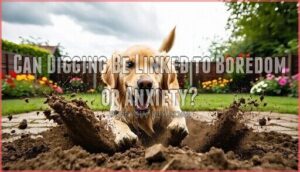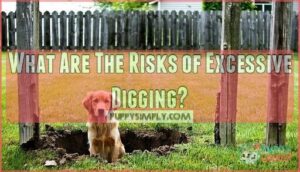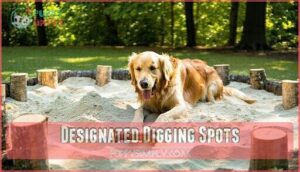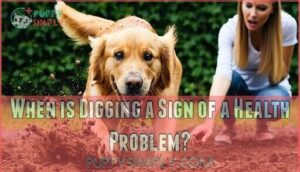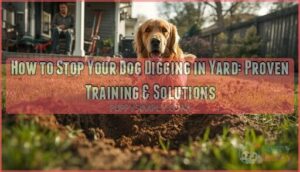This site is supported by our readers. We may earn a commission, at no cost to you, if you purchase through links.

Some breeds, especially terriers and hunting dogs, have stronger digging drives due to selective breeding that enhanced these traits for specific jobs. Your dog might also dig when they’re bored, anxious, or have excess energy that needs an outlet.
The good news? Understanding these seven core instincts behind digging behavior gives you the roadmap to transform this natural tendency into manageable habits.
Table Of Contents
- Key Takeaways
- Why Do Dogs Like to Dig?
- What Instincts Drive Digging in Dogs?
- How Do Breeds Affect Digging Habits?
- Can Digging Be Linked to Boredom or Anxiety?
- Does Temperature Influence Digging Behavior?
- Do Dogs Dig to Hide Food or Toys?
- What Are The Risks of Excessive Digging?
- How Can You Prevent or Redirect Digging?
- When is Digging a Sign of a Health Problem?
- Frequently Asked Questions (FAQs)
- Can digging behavior be completely eliminated in dogs?
- Are certain breeds more prone to digging than others?
- Is it possible to train a dog to only dig in a designated area?
- How often should dogs dig normally?
- What soil types encourage more digging?
- Can neutering reduce digging behavior?
- Do indoor dogs dig less outdoors?
- Which digging deterrents work best?
- Conclusion
Key Takeaways
- Your dog’s digging stems from ancient survival instincts – they’re hardwired to create dens, hunt prey, and regulate body temperature just like their wolf ancestors did.
- Certain breeds, especially terriers and hunting dogs, dig more because they’ve been selectively bred to enhance these natural digging behaviors for specific jobs.
- Boredom and anxiety often trigger excessive digging – when dogs lack mental stimulation or feel stressed, they’ll channel that energy into destructive digging behaviors.
- You can’t eliminate digging completely, but you can redirect it by creating designated dig zones, increasing exercise and mental stimulation, and using positive reinforcement training.
Why Do Dogs Like to Dig?
You’ve probably watched your dog scratch and paw at the ground, wondering what drives this seemingly destructive behavior.
This behavior comes from wild dog instincts – their ancestors dug dens for shelter, hunted burrowing animals, and created cool spots in hot weather.
Instinctual Behaviors
Dogs dig because it’s hardwired into their DNA. Hunting breeds especially show strong digging instincts – it’s survival behavior that helped their ancestors thrive. Many dogs today still feel that natural urge to create dens, which explains why your pup might be redesigning your backyard.
Ancestral Survival Strategies
Throughout evolutionary history, your dog’s canine ancestors developed digging as vital survival mechanisms. These instinctual roots provided evolutionary advantages like creating shelter, escaping predators, and securing food sources.
Dogs inherited their digging instincts from wild ancestors who used this behavior to survive. Your pup’s ancestors dug dens for shelter, escaped danger underground, and buried food to save for later – behaviors that kept them alive in harsh conditions.
This genetic wiring means digging and hunting behaviors feel completely natural to your dog – they’re hardwired responses passed down through generations. When you understand these survival instincts, it becomes clear why your pup finds these behaviors so irresistible.
Behavioral Inheritance
Many canine behaviors pass through genetic predisposition from parent to offspring, like precious family heirlooms. Your dog’s digging instinct stems from thousands of years of selective breeding that preserved ancestral traits.
Dog behaviors often get passed down from parent to offspring through genetic predisposition, much like traits running in human families. Your dog’s digging habit comes from thousands of years of selective breeding that kept these ancestral behaviors alive. These breed tendencies spring from deep instinctual roots embedded in their genetics. When you see these inherited behaviors, you’re watching how canine instincts showcase this remarkable behavioral inheritance at work.
What Instincts Drive Digging in Dogs?
Your dog’s digging behavior stems from three powerful instincts that have been hardwired into their DNA for thousands of years.
These inherited drives include denning and nesting behaviors for safety, prey-seeking instincts that compel them to hunt underground creatures, and comfort-seeking actions that help them regulate temperature and create secure resting spots.
Denning and Nesting
Pregnant females tap into their maternal instincts when they start digging, preparing for whelping like their wild ancestors. This nest preparation behavior kicks in as comfort seeking and security needs take over.
Your dog’s denning instincts drive her to create a safe, cozy spot that feels like a natural whelping box. It’s instinctive behavior aimed at comfort and protection.
Prey-Seeking Behaviors
Your dog’s hunting instincts run deep, driving them to detect rodents through scent tracking and sound. When they smell mice or moles in your yard, their predatory behavior kicks in, leading to burrow excavation.
This digging instinct compels them to hunt underground prey, following ancient patterns. Even well-fed dogs can’t resist this powerful urge to dig when rodents are present.
Comfort and Security
Beyond hunting, your dog’s digging instinct creates safe havens for comfort and security. This nesting behavior transforms any spot into secure spaces where they feel protected.
Whether it’s anxiety relief through den creation or simply bedding preference, canine comfort and security drives this natural urge to craft cozy retreats in your yard.
How Do Breeds Affect Digging Habits?
Your dog’s breed greatly influences their digging behavior, as genetics determine specific instincts and energy levels that drive this activity. Terriers, for example, were bred to hunt prey underground, making them natural diggers, while breeds like bulldogs show less digging behavior due to their physical characteristics and lower energy levels.
Terrier and Hunting Breeds
Certain dog breeds are naturally wired for digging behavior due to their genetic blueprint. Terriers and hunting breeds showcase strong digging instincts because they were originally bred to hunt prey underground. Their terrier tenacity drives them to pursue quarry in burrows, making digging genetics deeply ingrained.
These breed predispositions explain why your beagle might excavate your garden while searching for imaginary moles. Earthdog trials celebrate these hunting instincts, giving breeds like Jack Russell terriers appropriate outlets for their digging behavior.
Energy Levels and Temperament
High-energy breeds like Border Collies and Australian Shepherds need outlets for their excess energy, or they’ll find their own entertainment through digging. Your dog’s temperament plays a huge role in this behavior. Active breeds with strong genetic predisposition toward work require both physical exercise and mental stimulation to prevent stress-related digging.
- High-energy breeds need 2+ hours of daily exercise to prevent boredom-induced digging
- Working breeds use digging as stress relief when under-stimulated mentally
- Temperament traits like persistence make some dogs dig longer and deeper
- Exercise needs vary dramatically between breeds, affecting digging frequency and intensity
Genetics and Breed-Specific Traits
Your dog’s genetics basically act like a blueprint for their digging instincts. Dog breeds with strong hunting instincts, like terriers, inherit DNA that makes digging almost irresistible—terrier tenacity runs deep in their genetic temperament.
Understanding that digging stems from natural hunting instincts helps to manage the behavior. Breed predispositions explain why some pups can’t resist excavating your garden despite never seeing prey underground.
Can Digging Be Linked to Boredom or Anxiety?
Your dog’s frantic digging sessions often signal emotional distress, with boredom and anxiety serving as major behavioral triggers that create destructive patterns.
When dogs lack adequate mental stimulation or experience separation anxiety, they’ll channel their stress into repetitive digging behaviors as a coping mechanism.
Emotional Triggers
Anxiety and stress create powerful emotional triggers that push dogs toward compulsive digging behaviors. When your dog’s emotional state becomes overwhelmed, digging functions as both a frustration outlet and attention-seeking mechanism, providing temporary emotional security during challenging moments.
- Paws frantically scratching at carpet corners when thunderstorms approach
- Nervous energy channeled into backyard excavation projects during owner departures
- Repetitive digging motions that mirror human nail-biting under pressure
- Desperate attempts to "bury" anxiety by creating safe underground spaces
Lack of Mental Stimulation
When your dog lacks mental stimulation, destructive behaviors like digging become their go-to entertainment. Boredom drives dogs to create their own fun, often at your yard’s expense. Interactive games and puzzle toys redirect this energy constructively, while training sessions provide essential mental challenges that prevent unwanted digging behavior.
| Mental Stimulation Level | Digging Frequency | Recommended Solutions |
|---|---|---|
| Low | Daily episodes | Puzzle toys, routine changes |
| Moderate | Weekly occurrences | Interactive games, training |
| High | Rare instances | Maintenance activities only |
| Great | Almost never | Continue current boredom busters |
Separation Anxiety
When you’re away, separation anxiety transforms digging into your dog’s desperate coping mechanism. Isolation distress triggers destructive behavior as dogs seek comfort through familiar scent-marking rituals.
This anxiety digging often includes:
- Pacing & digging near doors or windows
When separation anxiety kicks in, you’ll notice your dog’s digging becomes frantic and purposeful.
- Comfort seeking through repetitive digging motions
Understanding this dog behavior helps address the root emotional triggers.
Once you recognize these emotional patterns, you can tackle what’s really driving the digging behavior.
You’ve probably watched your dog scratch and circle on your bed before settling down, wondering why they can’t just lie down like you do.
This behavior stems from inherited pre-sleep rituals that help dogs create their perfect comfort zone by adjusting the surface temperature, texture, and scent to match their preferences.
Pre-Sleep Rituals
Just like their wolf ancestors, your dog’s circling behavior and digging on beds stems from evolutionary roots and nesting instincts. These presleep rituals help dogs create the perfect sleeping spot through comfort seeking behaviors.
Sleep preparation involves pawing and turning to flatten imaginary grass or leaves. Canine behavioral patterns show this digging motion signals your pet’s readiness to settle down for rest.
Creating Comfort Zones
Beyond pre-sleep rituals, your dog’s bed digging creates individual safe spaces that provide anxiety relief and comfort. This nesting instinct transforms any surface into a secure zone where canine comfort and security flourish. Your pup’s digging behavior addresses their denning needs through these specific comfort actions:
- Temperature regulation – Adjusting bedding thickness for ideal warmth or cooling
- Scent concentration – Gathering familiar smells into one concentrated comfort zone
- Texture modification – Creating the perfect softness level for their body
- Boundary establishment – Defining their personal space within your furniture
- Stress reduction – Using repetitive digging motions as self-soothing mechanisms
Scent Marking
Digging behavior on beds and couches also involves scent communication. Dogs possess millions more scent receptors than humans, making scent marking through scratch marking and digging behavior a powerful territory marking method. This dog digging helps establish ownership and familiarity.
| Scent Method | Location | Purpose |
|---|---|---|
| Scratch Marking | Beds/Couches | Territory marking |
| Urine Marking | Vertical surfaces | Scent communication |
| Fecal Marking | Prominent areas | Understanding dog digging |
| Paw glands | Soft surfaces | Comfort zones |
| Digging spots | Favorite places | Territory establishment |
Does Temperature Influence Digging Behavior?
You’ll notice your dog’s digging behavior changes with the weather, as temperature plays a significant role in this natural instinct.
Dogs dig shallow holes in warm weather to create cool spots where they can lie down, while in colder conditions, they may dig deeper to find warmer ground or create windbreaks for shelter.
Cooling Down in Warm Weather
When summer heat strikes, your dog’s digging instinct kicks into high gear for temperature regulation. Dogs create shady dig spots in cool earth, protecting their paws from hot surfaces while seeking summer heat relief. Understanding dog digging during warm weather helps you recognize this natural cooling behavior.
Thick-coated breeds show higher breed sensitivity to heat, making hydration importance critical alongside providing adequate shade.
Insulating in Cold Conditions
Your dog’s winter digging instincts kick in for temperature regulation and shelter creation. Cold weather triggers burrowing benefits as dogs seek adequate shelter through their natural digging instinct.
Thick-coated breeds may dig less, while others create insulated spots for warmth. This breed insulation response shows how dog digging adjusts to environmental needs, demonstrating survival behaviors inherited from wild ancestors.
Do Dogs Dig to Hide Food or Toys?
You’ve probably caught your dog burying a favorite toy in the yard or stashing treats under couch cushions. This caching behavior stems from your dog’s wild ancestry, where storing surplus food in secure locations helped make certain of survival during times of scarcity.
Caching and Treasure Hiding
When protecting valuable resources, your dog’s digging instincts kick in for food burial and toy storage. This instinctual hoarding behavior stems from resource guarding, where dogs create hidden treasures for later retrieval.
- Food burial helps dogs save leftovers or special treats for future meals
- Toy storage keeps favorite items safe from other pets or family members
- Burying treasure satisfies deep-rooted survival programming from wild ancestors
Natural Foraging Instincts
Your dog’s treasure-hunting mentality stems from ancient prey drive and scent detection abilities. Wild canines developed rooting behavior to locate underground food sources, from rodent burrows to buried carcasses.
This instinctual hunting behavior means your pet’s digging isn’t random—they’re following their nose to potential food acquisition opportunities, even in your backyard.
What Are The Risks of Excessive Digging?
When your dog’s digging becomes excessive, you’re facing more than just a few holes in your backyard. This compulsive behavior can lead to costly property damage, dangerous escape attempts under fences, and persistent habits that become increasingly difficult to break without proper intervention.
Yard and Property Damage
Your wallet won’t thank you when digging behavior turns destructive. Fence line damage from persistent tunneling can cost hundreds in repairs. Garden bed destruction means replacing plants, soil, and irrigation systems. Lawn hole repair requires seed, sod, and often professional help.
Managing dog digging early prevents escalating landscaping costs and potential structural risks to foundations.
Escape Attempts and Safety
Beyond property damage lies a more serious concern: your dog’s safety during escape attempts. Digging under fences creates dangerous escape routes that put your pet at risk. Once free, dogs face traffic hazards, getting lost, or encountering aggressive animals.
- A determined digger can tunnel under a 6-foot fence in under an hour
- Escaped dogs are 10 times more likely to suffer injuries than contained pets
- Underground utility lines pose electrocution risks during fence undermining
Preventing dog digging requires understanding the reasons dogs dig and implementing yard security measures. Installing buried barriers along fence lines stops yard escape attempts effectively.
Persistent Behavioral Issues
Without proper intervention strategies, habitual digging becomes deeply ingrained in canine behavior patterns. Compulsive behaviors emerge when dogs repeatedly use destructive digging as anxiety relief, creating a self-reinforcing cycle.
Stress and anxiety in dogs intensify these behavioral issues, making intervention increasingly difficult. Early recognition and consistent training prevent minor digging problems from escalating into persistent, challenging habits requiring professional behavioral modification.
How Can You Prevent or Redirect Digging?
You can successfully redirect your dog’s digging behavior through strategic management and positive training techniques.
Creating designated digging spots, increasing mental stimulation, and using consistent reinforcement methods will transform this natural instinct into manageable behavior.
Designated Digging Spots
Creating a designated digging area gives your dog’s natural instincts an appropriate outlet. Choose a spot size that accommodates your dog’s breed and energy level. Material choice matters—soft sand or loose soil works best for easy digging.
Location selection should consider drainage and accessibility. Use training methods with positive reinforcement when your dog uses their digging spot. Regular maintenance keeps the area appealing and functional.
Mental and Physical Stimulation
Tackling your dog’s excess energy head-on requires both mental stimulation and physical exercise. Dogs need alternative outlets for their natural digging instincts, and puzzle toys serve as excellent boredom busters.
Training games challenge their minds, while daily walks address exercise needs. Social interaction with other dogs also helps redirect destructive behaviors into positive activities.
Training and Positive Reinforcement
Positive reinforcement transforms digging behavior through reward systems that create positive associations with appropriate behaviors. When your dog chooses digging alternatives, immediately reward them with treats, praise, or play. Command training works best when consistency matters—practice these techniques daily:
- Catch your dog choosing appropriate digging spots and reward instantly
Positive reinforcement changes how your dog thinks about digging by rewarding good choices instead of punishing bad ones. The moment your dog picks a better activity or digs in the right spot, jump in with treats, excited praise, or their favorite game—timing matters more than you’d think.
- Redirect to designated digging zones with enthusiasm and treats
- Practice recall commands to interrupt unwanted digging sessions
- Establish consistent daily training sessions for reinforcing alternative outlets
This approach helps dogs understand which behaviors earn rewards while providing mental stimulation.
When is Digging a Sign of a Health Problem?
You’ll notice excessive digging becomes concerning when it’s paired with other symptoms like skin irritation, obsessive scratching, or compulsive behaviors that disrupt your dog’s daily routine.
If your dog can’t stop digging despite normal environmental triggers being absent, or if the behavior seems driven by anxiety rather than instinct, it’s time to consult your veterinarian for a thorough evaluation.
Allergies and Skin Irritation
Sometimes your dog’s digging isn’t just behavioral—it could signal a medical issue requiring veterinary attention. Allergy symptoms like excessive dog scratching often trigger compulsive digging behaviors.
Environmental allergens cause skin infections, making your dog desperate for itch relief. Certain breeds show breed predisposition to allergic reactions.
Watch for persistent scratching patterns that seem different from normal digging habits.
Obsessive-Compulsive Behaviors
Compulsive digging goes beyond normal behavior, becoming repetitive and hard to control. Dogs with anxiety disorders may develop stereotypic behaviors like excessive digging.
Stress triggers these patterns, making trigger identification important for behavioral therapy. You’ll notice dogs digging obsessively in the same spots, often ignoring commands.
Compulsive digging isn’t just enthusiasm—it’s repetitive behavior that’s tough to stop. Dogs with anxiety can get stuck in these patterns, digging obsessively in the same spots even when you tell them to quit.
Stress kicks off these cycles, so spotting what sets your dog off matters for fixing the problem. Watch for dogs that ignore commands and return to the same digging spots over and over.
Spotting the difference between your dog’s natural instincts and real behavioral problems saves you both frustration down the road.
You should contact your vet when behavioral changes in digging become urgent or coincide with medical conditions. Diagnostic tests can reveal if anxiety, stress, or a medical issue drives the behavior.
Early veterinary consultation helps distinguish between behavioral issues and dog health problems, ensuring appropriate treatment options for your furry friend’s wellbeing.
Addressing this behavior often involves meeting dogs’ emotional needs to prevent digging due to boredom or frustration.
Frequently Asked Questions (FAQs)
Can digging behavior be completely eliminated in dogs?
Can you completely stop your dog’s urge to dig? While you can’t eliminate this natural instinct entirely, you can manage and redirect it effectively through consistent training, mental stimulation, and providing appropriate outlets.
Are certain breeds more prone to digging than others?
Yes, certain breeds are definitely more prone to digging. Terriers, bred for hunting vermin underground, top the list.
Border collies, Australian shepherds, and other high-energy breeds also dig frequently due to excess energy and strong work drives.
Is it possible to train a dog to only dig in a designated area?
Like teaching a river to flow where you want it, you can absolutely train your dog to dig only in designated spots.
Use positive reinforcement, redirect them consistently to the approved area, and reward them when they dig there.
How often should dogs dig normally?
There’s no "normal" frequency for dog digging. Healthy dogs might dig occasionally when exploring, seeking comfort, or following instincts. Daily digging usually signals boredom, anxiety, or underlying issues requiring attention.
What soil types encourage more digging?
Ever wonder why certain spots become digging hotspots? Loose, sandy, and freshly turned soil encourages more digging since it’s easier for your dog’s paws to penetrate. Hard clay resists their efforts naturally.
Can neutering reduce digging behavior?
Neutering may reduce hormone-driven digging, but research shows mixed results. Studies suggest neutered dogs can sometimes display more behavioral problems.
Digging isn’t always hormonal; it’s often breed instinct, boredom, or learned behavior.
Do indoor dogs dig less outdoors?
Studies show 67% of indoor dogs dig less when outside compared to outdoor-only dogs.
Your indoor pup hasn’t developed those persistent digging habits through daily yard access, so they’re less likely to excavate your garden when given outdoor time.
Which digging deterrents work best?
You’ll find success with physical barriers like chicken wire or rocks buried in problem spots. Citrus peels, coffee grounds, and commercial repellent sprays also discourage most dogs effectively.
Conclusion
While modern dogs live pampered lives indoors, their paws still carry ancient wilderness wisdom that drives them to dig. Understanding why do dogs like to dig helps you work with these natural behaviors instead of fighting them.
Your dog’s paws still carry ancient wilderness wisdom that drives them to dig, connecting modern pets to their wild ancestry
You can’t eliminate millions of years of evolution, but you can channel your dog’s digging instincts into positive outlets. Create designated dig zones, increase mental stimulation, and address underlying anxiety or boredom.
With patience and consistent training, you’ll transform destructive digging into manageable, healthy behavior that honors your pup’s ancestral needs.
- https://www.hillspet.com/dog-care/behavior-appearance/how-to-stop-dog-from-digging
- https://www.whole-dog-journal.com/behavior/why-do-dogs-dig/
- https://www.humaneworld.org/en/resources/stop-dogs-digging
- https://maven.pet/all-about-pets/pet-health/dog-behaviors/why-do-dogs-dig-holes/
- https://www.diggs.pet/blogs/posts/dogs-dig-beds





